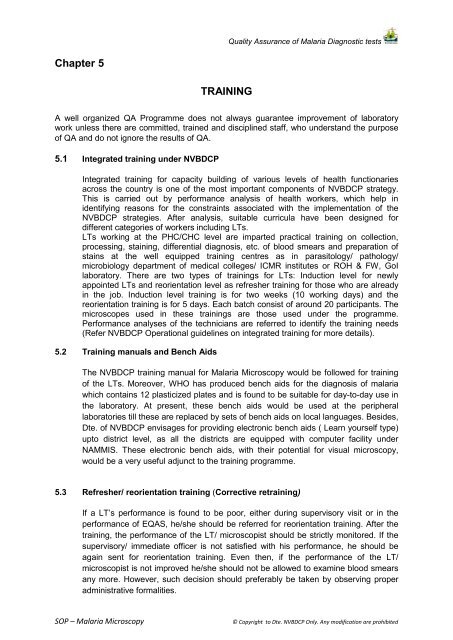SOP â Malaria Microscopy - NVBDCP
SOP â Malaria Microscopy - NVBDCP
SOP â Malaria Microscopy - NVBDCP
Create successful ePaper yourself
Turn your PDF publications into a flip-book with our unique Google optimized e-Paper software.
Quality Assurance of <strong>Malaria</strong> Diagnostic testsChapter 5TRAININGA well organized QA Programme does not always guarantee improvement of laboratorywork unless there are committed, trained and disciplined staff, who understand the purposeof QA and do not ignore the results of QA.5.1 Integrated training under <strong>NVBDCP</strong>Integrated training for capacity building of various levels of health functionariesacross the country is one of the most important components of <strong>NVBDCP</strong> strategy.This is carried out by performance analysis of health workers, which help inidentifying reasons for the constraints associated with the implementation of the<strong>NVBDCP</strong> strategies. After analysis, suitable curricula have been designed fordifferent categories of workers including LTs.LTs working at the PHC/CHC level are imparted practical training on collection,processing, staining, differential diagnosis, etc. of blood smears and preparation ofstains at the well equipped training centres as in parasitology/ pathology/microbiology department of medical colleges/ ICMR institutes or ROH & FW, GoIlaboratory. There are two types of trainings for LTs: Induction level for newlyappointed LTs and reorientation level as refresher training for those who are alreadyin the job. Induction level training is for two weeks (10 working days) and thereorientation training is for 5 days. Each batch consist of around 20 participants. Themicroscopes used in these trainings are those used under the programme.Performance analyses of the technicians are referred to identify the training needs(Refer <strong>NVBDCP</strong> Operational guidelines on integrated training for more details).5.2 Training manuals and Bench AidsThe <strong>NVBDCP</strong> training manual for <strong>Malaria</strong> <strong>Microscopy</strong> would be followed for trainingof the LTs. Moreover, WHO has produced bench aids for the diagnosis of malariawhich contains 12 plasticized plates and is found to be suitable for day-to-day use inthe laboratory. At present, these bench aids would be used at the peripherallaboratories till these are replaced by sets of bench aids on local languages. Besides,Dte. of <strong>NVBDCP</strong> envisages for providing electronic bench aids ( Learn yourself type)upto district level, as all the districts are equipped with computer facility underNAMMIS. These electronic bench aids, with their potential for visual microscopy,would be a very useful adjunct to the training programme.5.3 Refresher/ reorientation training (Corrective retraining)If a LT’s performance is found to be poor, either during supervisory visit or in theperformance of EQAS, he/she should be referred for reorientation training. After thetraining, the performance of the LT/ microscopist should be strictly monitored. If thesupervisory/ immediate officer is not satisfied with his performance, he should beagain sent for reorientation training. Even then, if the performance of the LT/microscopist is not improved he/she should not be allowed to examine blood smearsany more. However, such decision should preferably be taken by observing properadministrative formalities.<strong>SOP</strong> – <strong>Malaria</strong> <strong>Microscopy</strong>© Copyright to Dte. <strong>NVBDCP</strong> Only. Any modification are prohibited
















